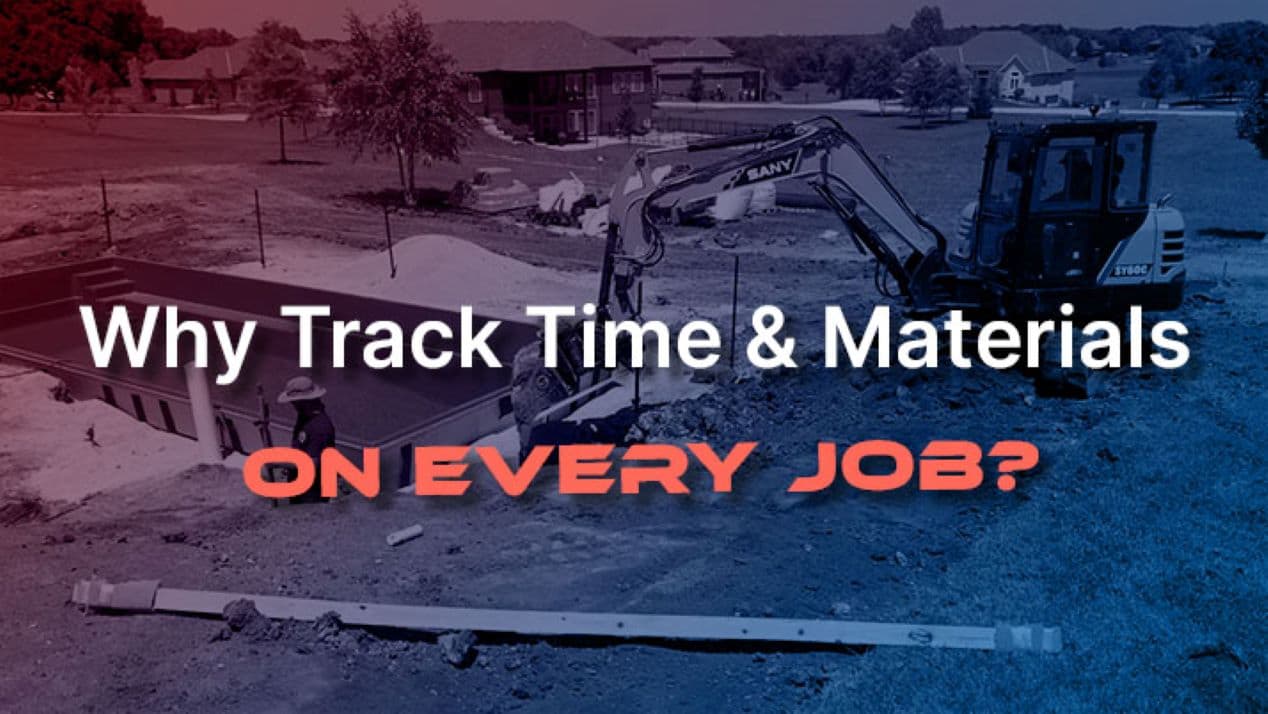Why Track Time & Materials on Every Job?

Do YOU track time & materials on every job?
The last thing you need is another item on your plate. And that’s exactly what taking time to track materials and time on your jobs feels like. Yet another item on the to-do list that isn’t getting done.
When you’re an owner-operator of a landscaping business, you’ve got a lot on you. Most likely you’re still out in the field, making sure jobs get done, logistics go smoothly, materials show up on time, handling customer complaints, employee challenges… the list goes on.
Then you get to do estimates at night yet. (I’m kidding, hopefully not 😥)
And after a while, ya know, it’s just easier to prioritize the urgent, not the important.
I think we could agree that tracking every material, receipt, and minute of time on a job is, well, hard. Right?
Yes.
Do you know what else is hard?
Working your tail off all year, getting to the end of the year, and there are pennies in the checking account.
That’s hard.
Back to the tracking. To pull it off and do it well consistently requires systems and processes, and then the discipline and leadership to follow them. And yep, building systems and processes is hard.
That said, if you don’t, you’ll be stuck in your owner-operator entrepreneurial prison forever. You’ll be the only guy that knows how to do stuff.
Systems and processes are what help your team around you know what to do.
Why you need to track
Let’s talk for a minute about WHY you need to track materials and labor on a per-job basis.
To avoid getting to the end of the year and not having anything to show for it, you need to be making a profit. To make a profit you need to get the math dialed in on your estimating, ensuring you’ve got your labor, materials, equipment, overhead, and profit margin covered. Building a company budget will dial in that math for you in a jiffy, giving you awesome clarity and confidence that you’re numbers are spot on.
But, that math is only half the battle.
You can build an estimate with “perfect on paper” math.
But if you estimated that the job would take 100 hours, and it took 130, that’ll wipe out your profit just as badly as if you had made a grave error in your estimating math.
The same goes for materials. If you estimated 20 tons of stone, but then it actually took 35 tons, that comes straight out of what was supposed to be your profit.
You must track to compare
And that’s why tracking is so important. Getting the math dialed in is only half the battle. You’ve got to track your actual labor and materials, and then compare them with your original estimate, to observe where you were off, learn, and make notes and adjustments for the next estimate.
Don’t make the same mistake twice.
Not tracking is a little like taking a rifle to the shooting range to sight it in, carefully measuring the distance to the target, settling in on the sandbags, and gently squeezing the trigger to pull off the perfect shot….
…and never looking where you hit.
Then you shoot again.
And again.
You could be completely missing the target. But you don’t know it.
You could be completely missing it on your estimates.
But you won’t know it until you run out of cash in the checking account.
By then, ummm… it’s really late to be responding to the problem.
Sometimes it is not always that obvious either. Maybe you’re making great money on certain types of jobs, but then others do really poorly, and rob the profit from the great jobs. At a high level, it just looks like your business is not as profitable as it should be, when in fact you have some really profitable jobs and some that are losing you money.
Some tips on setting up your systems and processes to make tracking jobs easier:
- make sure every receipt has a PO on it. Don’t let your team pick up materials without getting the vendor to add a PO to the slip.
- Pay your crew based on the hours tracked to the job. A time clock on the shop wall doesn’t count. Use a time tracking app (like SynkedUP) and track every minute of payroll to a specific job. Unbillable time like cleaning trucks, meetings, etc can go to a job named Shop Time. If you don’t pay your crew based on these hours tracked to jobs, don’t expect it to be accurate. I’ve talked to folks who try to do both a payroll time clock, and then also track time to specific jobs. It won’t work.
- Sit down for a hot minute with your team and brainstorm how you can design your process to track things in a way that is simple, lightweight, and effective. It has to be simple and lightweight, otherwise, it won’t get done. But you must be consistent, or you won’t be able to trust the data you did track.
In the end, yes…
Both ways are hard.
Which hard do you want?
The “hard” of disciplining yourself to a system and process so that you can see where you hit when you squeezed off the shot, and make adjustments to your scope?
Or the “hard” of working your tail off all season, sacrificing your evenings, family time, and not having the reward to show for it?
There are many ways
There isn’t only one way to skin this cat of tracking. But it’s important that you find what works for you. I built SynkedUP for this exact purpose, after working in the field for 15 years myself. Get on a call if you want to check it out, Gene or I’ll be happy to show you how it works.
I’d like to hear from you about what’s worked best for you in your business. Drop a comment if you’re reading this on the blog, or hit reply if you’re reading this in an email. I’m always listening for ideas on how to make this easier.
👋
Weston Zimmerman
SynkedUP CEO & co-founder

Weston Zimmerman
CEO and co-founder
See SynkedUP in action
Related Articles
Employee Complaint? Do This Next Time.
Employee Complaint? Do This Next Time. Had An Employee Complaint? Have you ever had an employee complaint? I’m sure you...
Are You “The Best” Contractor In Your Area?
Are You “The Best” Contractor In Your Area? “The Best” Can you make a better burger than McDonald’s? Can you...
Making Money? Time for the Mid-Year Check
Making Money? Time for the Mid-year Check Making money? It’s that time in the heat of summer again! Are you...
Improving Your Sales Skills Through Authenticity
Improving Your Sales Skills Through Authenticity Can you improve your sales skills? I was inspired to write this today from...
Feeling Resentment? Where Does It Come From?
Feeling Resentment? Where Does It Come From? Where does resentment come from? I was on a call last week with...
What Are You Putting Off?
What Are You Putting Off? What are you putting off? Today’s blog is a bit different. I’m zooming out, talking...
The Power of Job Costing
The Power of Job Costing The Power of Job Costing The power of job costing. It can mean the difference...
Pricing Estimates Profitably With An Updated Budget
Pricing Estimates Profitably With An Updated Budget Pricing estimates profitably with an updated budget It’s that time of year where...
Should Contractors Give Discounts?
Should Contractors Give Discounts? Should contractors give discounts? Should we as contractors give discounts on jobs? I dare say we’ve...
How to Create Estimating Templates and Production Rates
How to Create Estimating Templates and Production Rates Estimating Templates and Production Rates You want to cut estimating time by...









